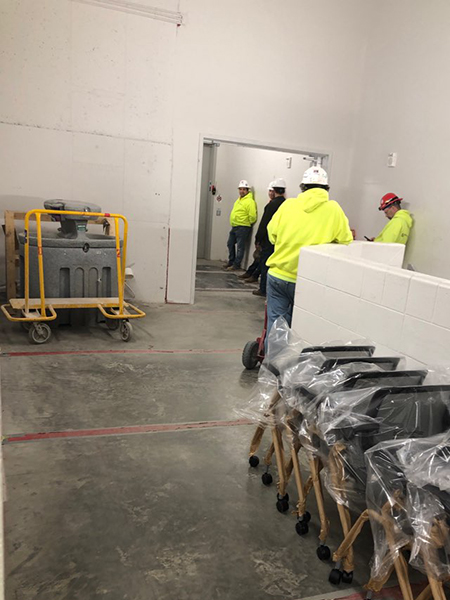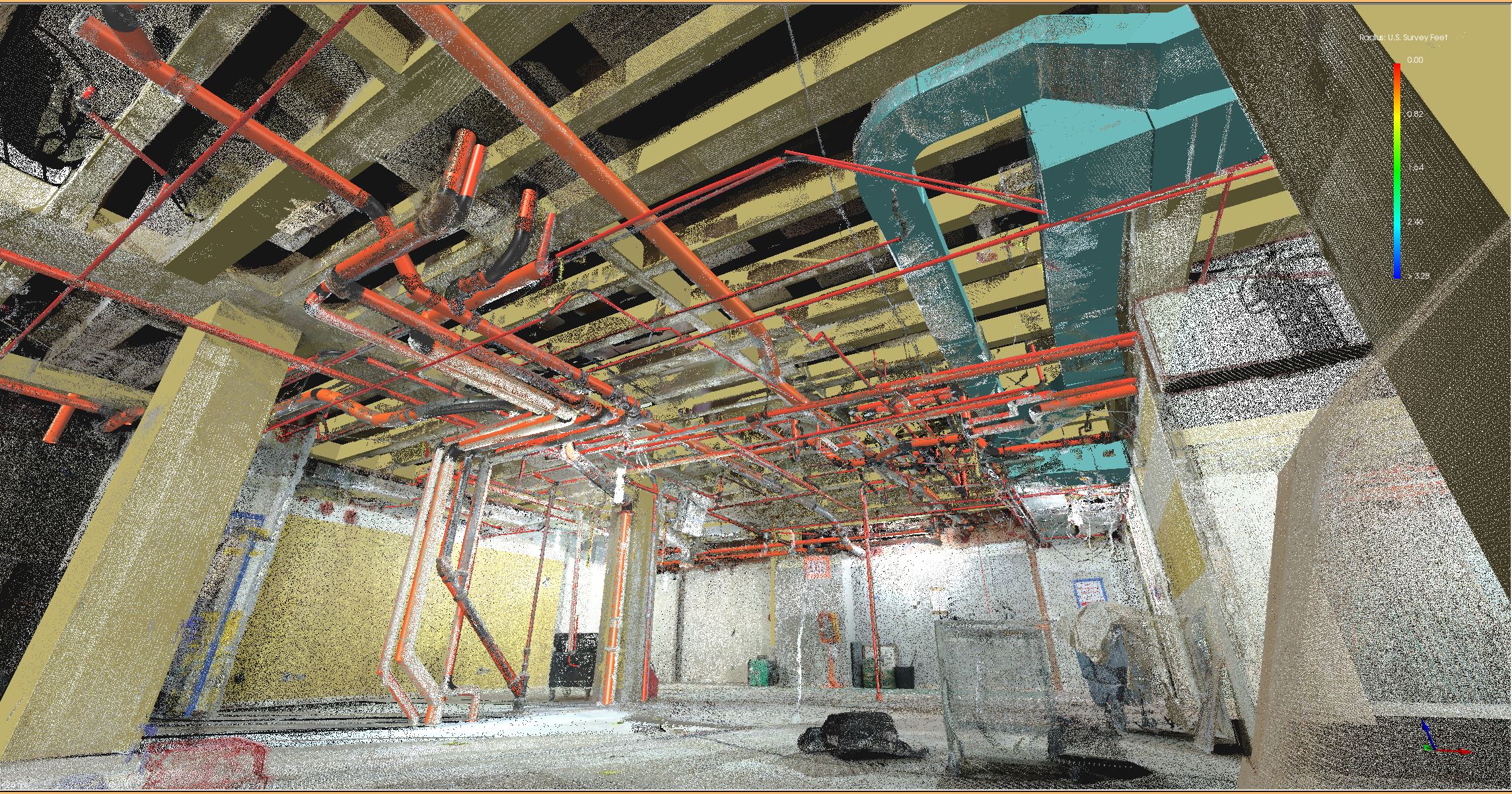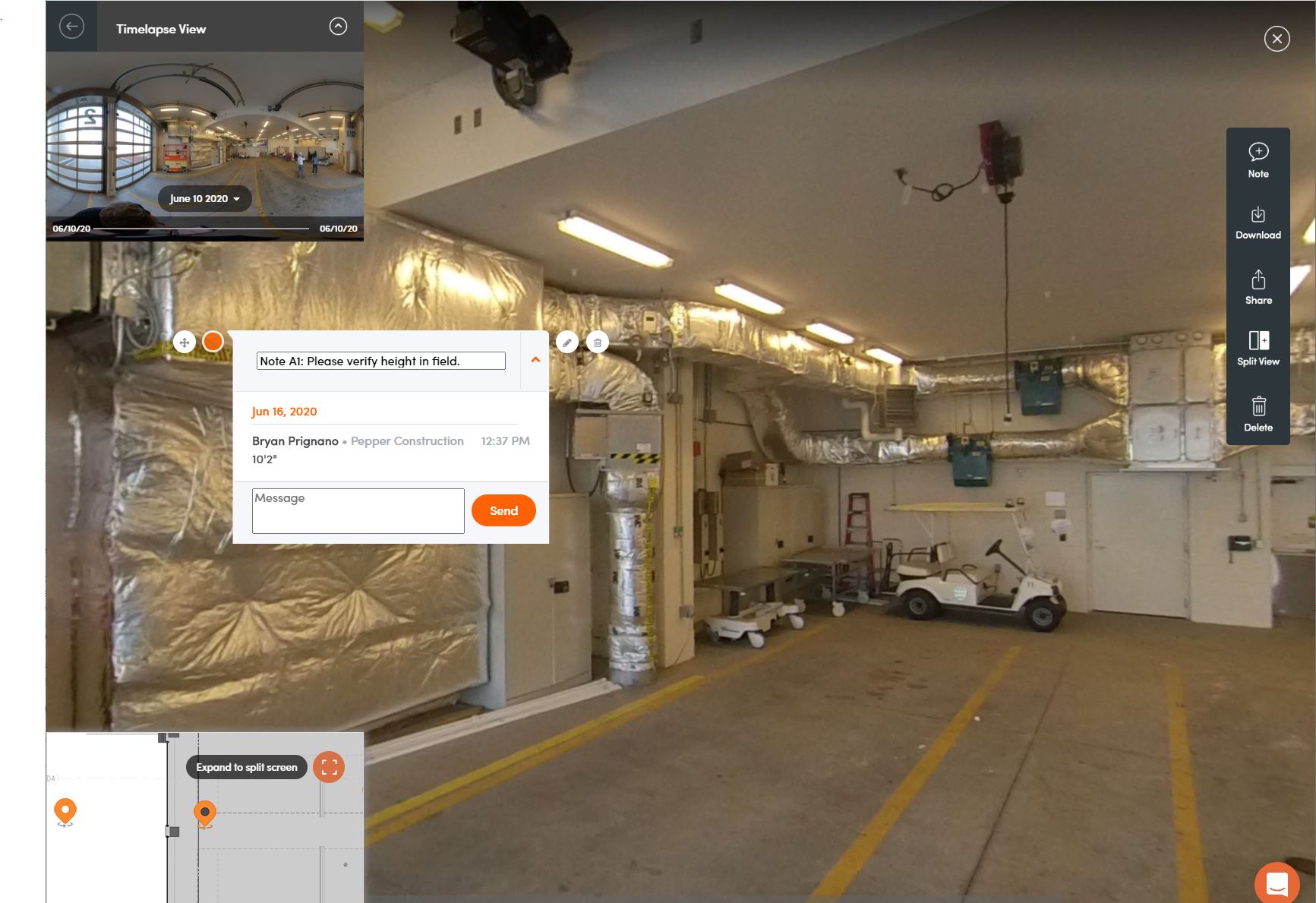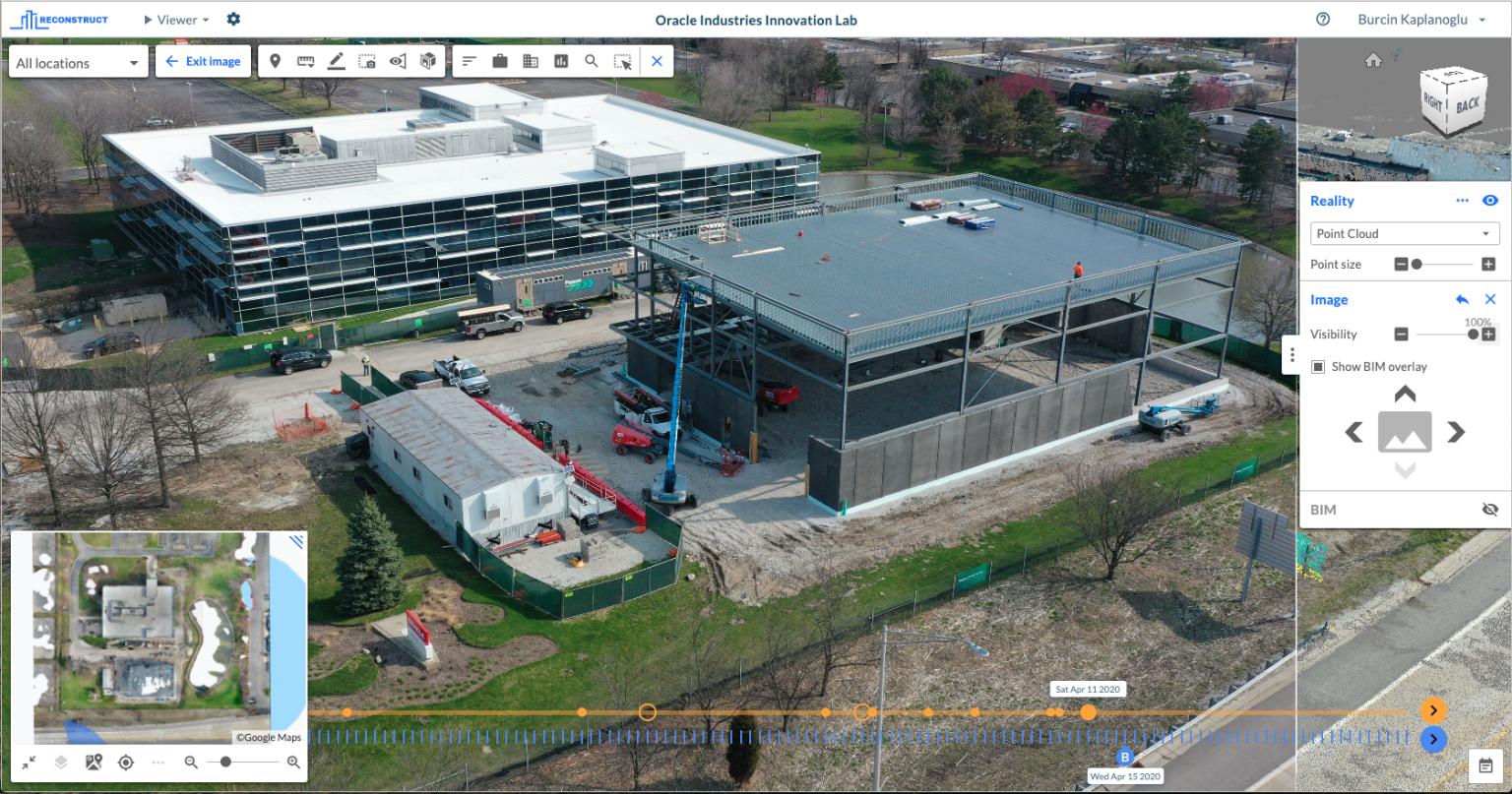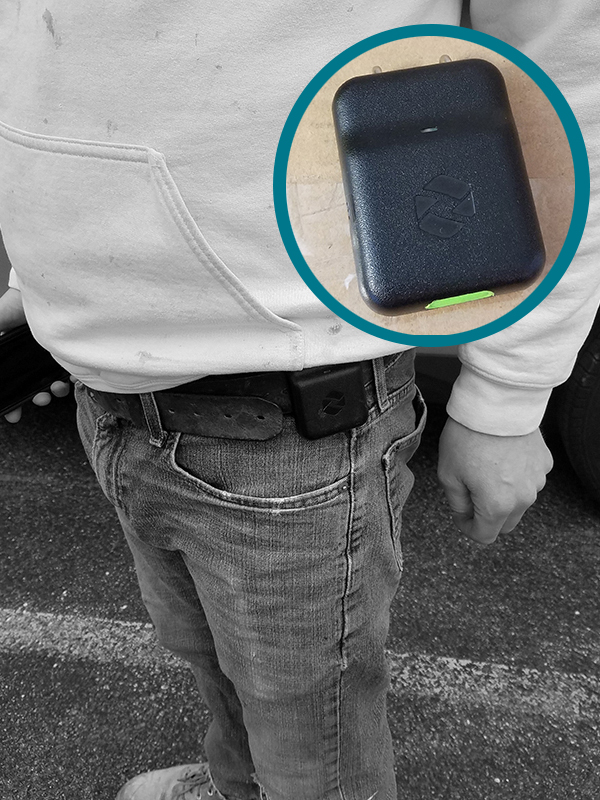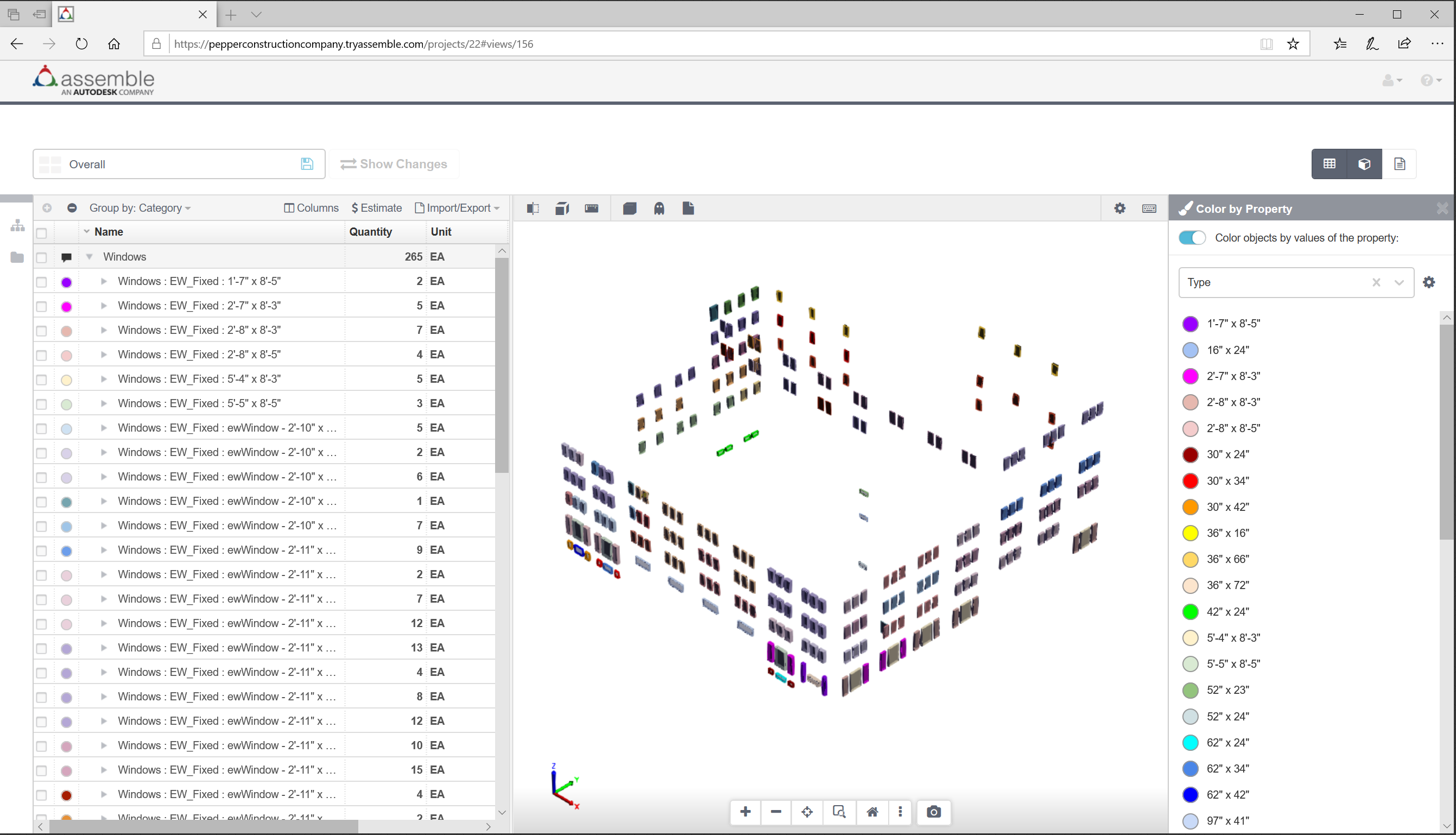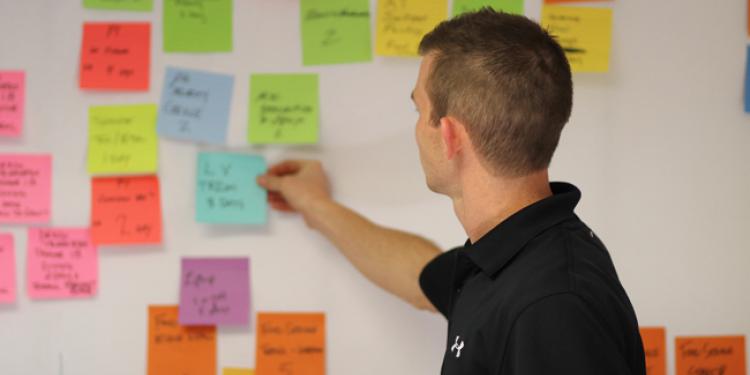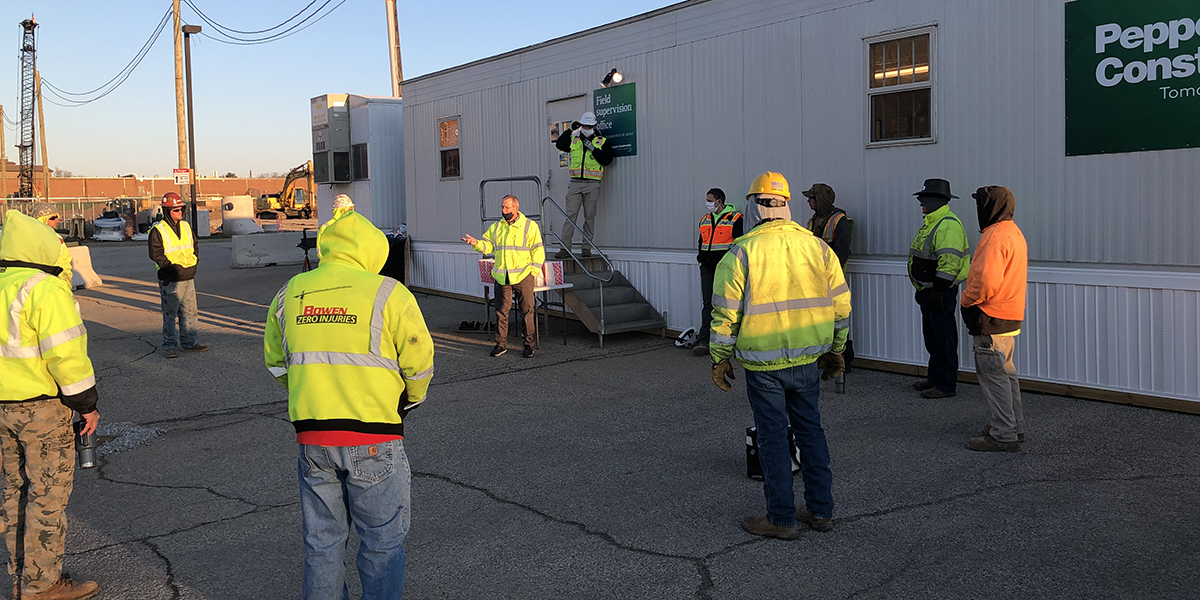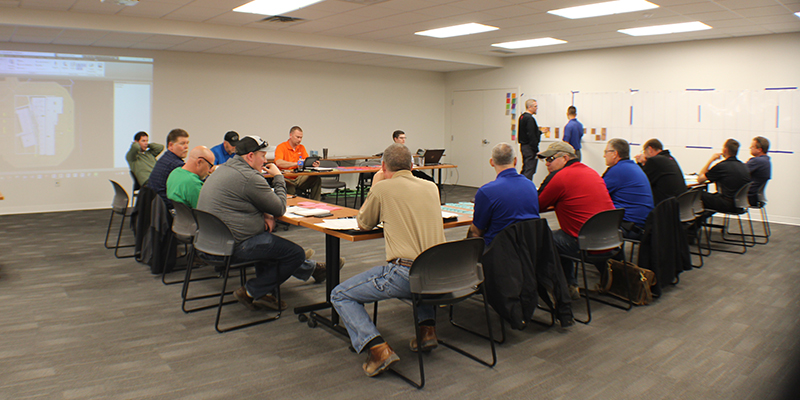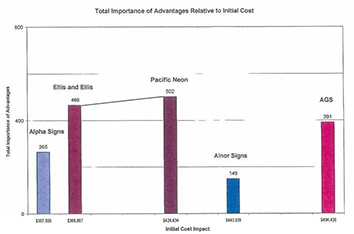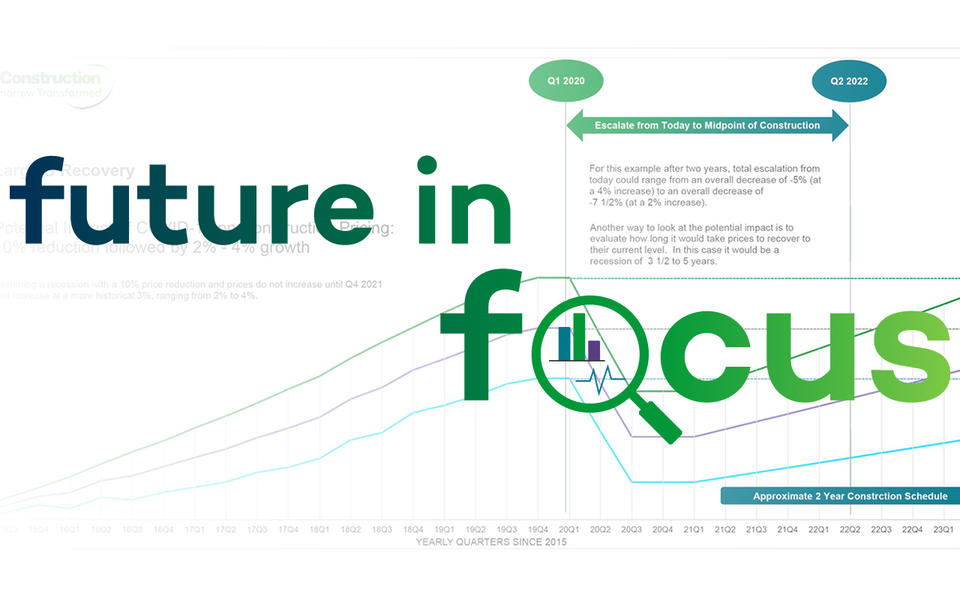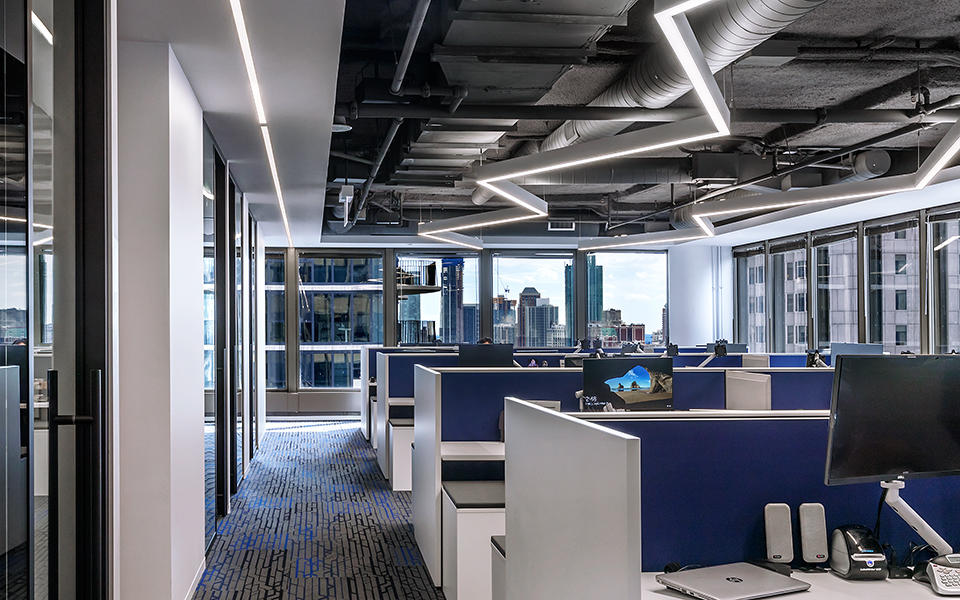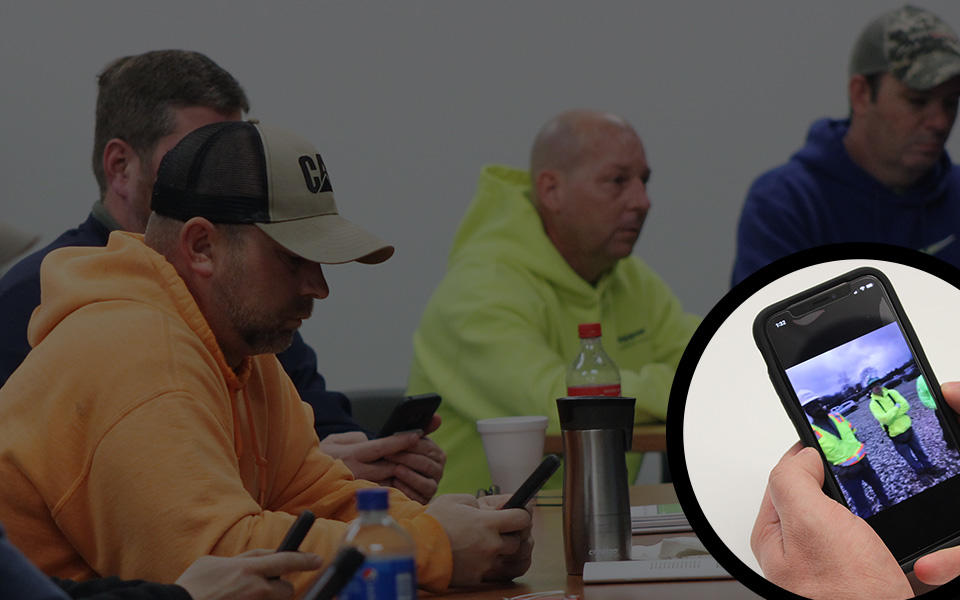Virtual construction & technology, Lean Construction, Future In Focus
Future in Focus
How Lean Construction and technology facilitate progress amid change and uncertainty
One of the challenges we've faced working in this COVID-19 construction environment over the past few months is stopping to consider how we can safely re-tool how we work - while we work. As people have grown accustomed to operating under an expanded set of guidelines that slowed - and even stopped - productivity in some instances, we've actually developed some improved workflows and glimpses of innovation.
Though the circumstances are unique, the situation itself is quite common: When unforeseen conditions impact a project, how do you adjust the plan to achieve expected results?
To help find efficiencies, we ask ourselves: How can we use Lean principles and leverage technology to meet our clients' needs?
Finding efficiencies with new procedures
Senior Vice President Jeff Johnson leads our business in Wisconsin. When the new jobsite requirements resulting from COVID-19 were released, he approached the situation from his experience with Lean Construction over the past 20 years.
"When the virus hit, we had to make some adjustments, and adapting plans is where lean thinking is most effective. To get our projects up and running under new guidelines, we had conversations with the trades about what would work best. We weren't deliberately following the principles of lean construction; it's just how we are used to approaching problem-solving."
For example, on one project, the team worked with the owner, pre-turnover, to use the new passenger elevators to transport workers to and from the upper floors. The freight elevator was designated for material transportation only, and trades working on the lower floors used the stairs. Previously, people and materials both moved only through the freight elevator.
"We were forced to rethink the logistics of moving materials and people, which actually made us more efficient from a workflow perspective," explains Johnson.
Will remote working end collaboration?
One of the biggest challenges of working in a COVID-19 environment is how to simulate in-person collaboration in a way that brings value. It’s a question with broad reach, and it's even sparked a debate in our industry: Is this the end of collaboration – at least, as we know it?
According to Johnson, sometimes trying to take a process that people don’t fully understand to begin with and making it virtual, can be less effective.
Take pull planning, for example, where the trades responsible for supervising the work meet on-site to collaborate on the schedule. Before the pandemic, technology existed to manage pull plan schedules virtually, through platforms such as TouchPlan, but teams struggled with it because they didn't understand how to do pull planning. When done virtually, it has to be managed in the right way. Otherwise, we can miss the value of people connecting, making commitments in person, checking in and reporting out.
Touchplan used on a jobsite.
Does this mean we forget the technology? At Pepper, the answer is an emphatic no! We believe remote working has heightened the need and technology has opened new doors for engagement.
Choosing the right technology for collaboration
With her finger on the pulse of innovation in the field, Vice President of Technical Services Jennifer Suerth has been exploring opportunities to maximize technology integration with impact beyond the immediate context.
“The challenge to improve collaboration has always been there,” explains Suerth. “The pandemic really amplified it and also exposed ways to be a better partner.”
The solution is about more than putting a conference call on Zoom or adding a live stream. Under the duress of delay and uncertainty, integrating technology relies, instead, upon a twist to the classical question about the half-empty/half-full glass.
“The question now is: How can I maximize the glass in front of me to make it full of something better?” says Suerth. “It is, and has always been, about being a good partner. Now, especially, it’s also about more creatively leveraging tools Pepper already has to keep our clients informed and their visions alive - because our clients are already familiar with them.”
Understanding that innovation emerges from the contextual needs of each individual project, we have found three applications for optimizing technology resources toward improved collaboration under any, but especially current, market circumstances. These ideas originated with the tools we already had at our fingertips.
01. Capitalize on reality capture in new ways
It has been common practice in our industry to create 3D models from photographs or laser scans to improve accuracy, quality, productivity and safety on our projects. We have used the digital data and 3D models to inform the project planning and installation. These tools have connected people through sharing insights and problem-solving.
Making progress in our current environment demands a more elastic approach with reality capture – one that stretches to include bringing people to jobsites when they can’t physically be there. Below, we've compared different tools to understand the situations in which each can bring the most value.
Videoconferencing
Beyond virtual meetings, videoconferencing platforms like Microsoft Teams, Zoom and FaceTime have been used to conduct jobsite tours for inspections. We also use infrared cameras, GPS and photogrammetry afforded by drones to gather current site conditions, move remotely through an architect’s punch list or walk a client through a jobsite while restrictions on travel and physical proximity are in place.
Web cams
Most projects have web cams, and shelter-in-place has brought to light added utility. Earthcam, Sensera and OxBlue provide easy ways for the team to check in on project sites without leaving home.
Before COVID-19, a superintendent would sometimes conduct a weekend visit to make sure there were no access issues and progress was on target. With the distance and travel, it could make for a long day. Leveraging the webcam and sensors to alert the superintendent as to who came through the gate means he doesn't have to leave his home to do the same work.
In addition to seeing progress and conducting security checks, captured web cam scenes used as a backdrop for a virtual meeting are putting participants on-scene to hear planned work for the day. Some teams have even mounted them in jobsite conference rooms to continue virtual meetings as offices reopen.
Virtual assist
Hands-free virtual assist technology expands the use of these spaces to conduct remote training, troubleshoot or even maintain equipment.
A little creativity is key to finding new utilization. “I could see our MEP team, for example, walking someone through how to fix or start up a piece of mechanical equipment remotely,” says Suerth. “Our quality team may also find it useful for explaining to someone in the field how to configure a unique enclosure system.”
Since COVID-19 came on the scene, it’s crucial that strategies integrate technologies that reduce resources required to perform tasks, as well as the feeling of separation brought on by the remote nature of the work environment. It's important to make all virtual interactions count.
Comparing Reality Capture tools
There are many options for capturing and recreating conditions, and each has its advantages and limitations. To make it easy, we put together a basic comparison, followed by examples of each.
Click on the plus signs in the image above for more information.
Drones
Drones offer more than a birds-eye view. They capture a broad set of data in a short amount of time and can reach heights that are hard to access for our team members. As such, they provide quality management and safety advantages in the right situations.
Watch how photos from a drone are used to build a 3D model.
Laser scanning
To optimize the schedule, clients have provided access to inactive spaces that would have otherwise been filled with people. By capturing existing conditions with laser scanning, we can obtain quantifiable data that informs the project plans.
360° tours
With a 360° hand-held camera and a smart phone or tablet, one person in the field can document progress during a site walk, and it will be organized automatically on a floorplan. 360° photos are common across projects.
Linking this existing technology to a platform like StructionSite brings everyone to the jobsite virtually. It allows others to walk the site remotely, view and tag items as if they were on site, and share information readily. Images organized by location and time can be compared to a 3D model to visually identify differences and enhance coordination between contractors and tradespeople.
Extending construction technology to the client's business
Client need is the ultimate driver. For example, when a client, wishing to market available lease space, struggled to get people there for a physical tour, we adapted existing reality capture technology to create a virtual visit.
Click on the black dots in the image above to take a virtual tour of the space.
If a one-point solution is preferred, artificial intelligence can be layered in or a platform like Reconstruct can be used, which brings together all reality capture data, the model and the schedule. These solutions allow progress to be managed more proactively and precisely, including detecting past, current and future performance issues. They also give project stakeholders a view of progress in real- or near real-time.
Robots
Automating the collection of reality capture data by leveraging autonomous robots like Boston Dynamic’s Spot, potentially enable more tasks to be completed with the same amount of labor. Attaching a laser scanner or camera on top of Spot offers additional quality management opportunities. Robots can also help with social distancing protocols.
We are using Boston Dynamic’s Spot on a current project in Illinois and predict we will see a lot more of this technology on future jobsites. Video courtesy Faro and Oracle.
"In construction, robots have not eliminated jobs, and they are not fully autonomous yet. Instead, they are changing the roles of workers on site, making them safer and more productive," comments Suerth.
02. Elevate Safety
The health and safety of those in and around our projects has always been our top priority, and this concern has become even more amplified with the potential presence of a virus that spreads easily.
Artificial Intelligence
Smartvid.io already captures images on sites and detects where workers are and whether they are wearing PPE. Thinking of the new social distancing requirements, Suerth wondered: What if this technology could also monitor grouping and social distancing guidelines?
The question was answered by "Vinnie," Smartvid.io's Artificial Intelligence (AI) engine that was introduced at an Oracle Corp project in Deerfield, Illinois. Vinnie can flag actions that take place in groups or within six feet of others on-site, which means team members are better equipped to keep themselves and others safer. Insurers and regulators can see that OSHA social distancing recommendations are being maintained and monitored. For owners, this brings more reliable data to inform decision-making on resource allocation.
The technology continues to evolve. We're now working on integrating this platform with webcams to secure more timely data uploads, and we recently rolled out new functionality around customized alerts that tag specific PPE and allow people to work in close proximity.
Sensors
As we see areas re-open, the potential also opens for Proximity Trace and wearable IoT sensor technology, like Triax, to further enhance safety. Data captured through wearable devices allow for contact tracing that helps determine employee risk in the event of COVID-19 exposure. On projects where Pepper is already integrating solutions like Spot-r, which enables remote safety management of people on-site, leveraging such added functionality is a natural next step.
Mass notification platforms
The pandemic has intensified the weight of timely, precise communication. With a simple text through a mass notification system, such as Rave®, we can share project-specific safety information with employees within seconds. We are also exploring opportunities for including temperature reading and contact tracing, among other activities, to ultimately target communications to the appropriate audiences.
"While automated utilization, worker-generated safety alerts and real-time location data help manage workers on-site, safety is ultimately everyone's responsibility," reiterates Suerth.
03. Tie tech to Lean
Responsible application is at the core of our approach to tech integration. “Maximizing value, minimizing waste is the Lean thinking that’s embedded in every Pepper project,” says Johnson. “We use technology to strengthen communication and inform decision-making around targeted planning and execution.”
When considering how to proceed with a project, technology is a tool to implement Lean thinking. Applying technology options early in the decision-making process that are already done remotely, such as modular construction, virtual mock-ups, and 3D coordination, keep projects moving forward. Leveraging the 3D model for all aspects of the project – from model-based estimating and Target Value Design to coordination and cloud collaboration – help with visualization and bring clarity from beginning to end. In the past, these activities were particularly helpful for partners located out of town, and now that everyone has been working remotely, they are applicable on all projects.
How lean facilitates the process of proceeding
Looking at the options for proceeding that Senior Vice President of Preconstruction Scott Higgins outlined in the first post, Bringing the future of construction into focus, Lean strategies and technology can be applied in each situation to bring efficiency.
Working toward a stopping point
The earlier we coordinate, the better for the project, even when the field may need to stop working. For one project that went on hold in the midst of foundation and underground work, thoughtful coordination led to a safe, logical stopping point that will avoid rework and allow progress to continue later. Building offsite in a controlled environment, where you can do so safely and at your own pace allows for the construction schedule on site to speed up when the project starts again.
Ramping back up
Lean Construction can be a powerful strategy for getting projects back on schedule, whether returning from a shut-down or when other unforeseen circumstances impact the timeline. Applying the principles at the start of a project makes ramping back up much easier because trust and buy-in have already been established. The trades also know what we mean when we talk about pulling back the schedule to make up time.
When a project stops, companies move workers to other jobs to keep them busy. Upon return, typically, we lose one or two days of full production because manpower is slow to come back. We use the time during a shut-down to continue to assess the situation and adjust the plan, with consideration for crucial trades that have the potential to hold up others. We keep the conversation going among trades and talk specifically about the time lost and how the days can be made up collectively as a team.
"Lean is about making reliable commitments and trying to remove uncertainty," explains Johnson. "And communication is critical."
When it comes to COVID-19, there are a lot of emotions associated with the safety of our frontline workers in the field - around testing, contact tracing, cleaning and communication across trades. Additional measures like temperature checks, assigned gates for entering and exiting, wearing masks and social distancing are proactively communicated so tradespeople know where to go and what do to before they get there. Communicating in advance helps mitigate uncertainty.
Once the workers are on site, daily huddles provide a forum to answer questions and brainstorm ideas, so everyone is comfortable with their work environment.
Accelerating to completion
The benefits of Lean Construction are realized when decisions happen early-on about where to invest to remove future risk – for the benefit of the whole project. For example, because of COVID-19, we're getting a late start on a new project. Before proceeding, we're working on a plan for strategic overtime that allows us to get enclosed before winter and maintain the overall schedule.
A good plan involves the trades and considers the handoff of work between them so extra shifts and overtime are limited. When the trades commit to a shared plan it removes constraints and uncertainty and creates the best conditions for acceleration because they think about the success of the entire project and not just their specific role. It's the same concept during design. When Target Value Design is used, we don't have to wait for the full design to be completed. The architect focuses on the designs that allow for an earlier start on construction.
The cost factor
When considering the cost of Lean and technology, it's important to understand that they tend to be used early, during preconstruction, to plan for potential issues, and the return is experienced later in construction, often in the form of a cost avoidance and efficiency. While this makes it challenging to quantify the return on investment, we know the extra time spent during planning and the cost of technology can be easily offset by a single issue that was avoided.
The Lean principle of Choosing By Advantages (CBA) helps owners make decisions for their projects by comparing the advantages of different options based on multiple factors, technology included.
When technology is involved, the choices aren't always as straightforward as they may seem. For example, building faster and ending earlier should in theory save money, but in some cases, it may require doubling or tripling crew sizes to hit those targets (which may not even be a possibility right now). However, if technology could be used to find efficiencies, two people may be able to do the work faster than three people, making potential overtime more affordable. Or maybe the overtime isn't needed at all. The technology has a cost, but it could be less expensive than the additional labor, resulting in an overall cost savings for that acceleration strategy.
Our industry is experiencing projects starting late because of COVID-19, making speed a major driver, and the smartest way to make up the time is in the planning process, when changes are less expensive to make.
The human factor
In an article published by Construction Dive, Suerth was quoted: “You need to evaluate why you want to do something before you choose what you’re going to implement. Some of it is just leaving technology out of the equation to begin with. Otherwise you just become a solution looking for a problem and it might not be the problem you were trying to solve.”
As dynamic and powerful as technology can be, it’s up to the team to drive solutions. In a landscape that is changing daily, the constant that jumps to the foreground is knowing the right people are applying the right tools at the right time.
From preconstruction through construction, opportunities exist to harness reliable commitment, methodical execution, and efficiency. “The innovation that we've experienced through emerging technology,” says Suerth, “is really activated vision. We already have the tools; we’re simply engaging our creativity to solve problems."
A better way to build - to see tomorrow transformed
As we emerge from this situation, the conversations in the design community are centered on creating healthier and more resilient spaces that can better adapt to changing needs. While we couldn't predict a pandemic, at Pepper, we remain steadfast in doing our part to help our industry make healthier and more sustainable long-term decisions. We believe many innovations around high performance solutions will arise. Technology will be key to making them a reality, and Lean Construction will facilitate a quicker adoption into our projects.
This blog post is part of a new series that analyzes the decision to proceed, as well as the creativity and tools to wisely manage your project. Experts from across the company are weighing in so you can start to sort through all the unknowns and make the most informed decisions possible. The first post in our series, Bringing the future of construction into focus, shared an industry analysis and potential pricing outlook based on different recoveries. Next, we'll take a deeper dive into some specific markets to better understand what's driving them, where they are headed and how to think differently about your project during this time. We encourage you to subscribe to our newsletter to receive updates.
SIGN UP TO RECEIVE UPDATES
About the Authors




